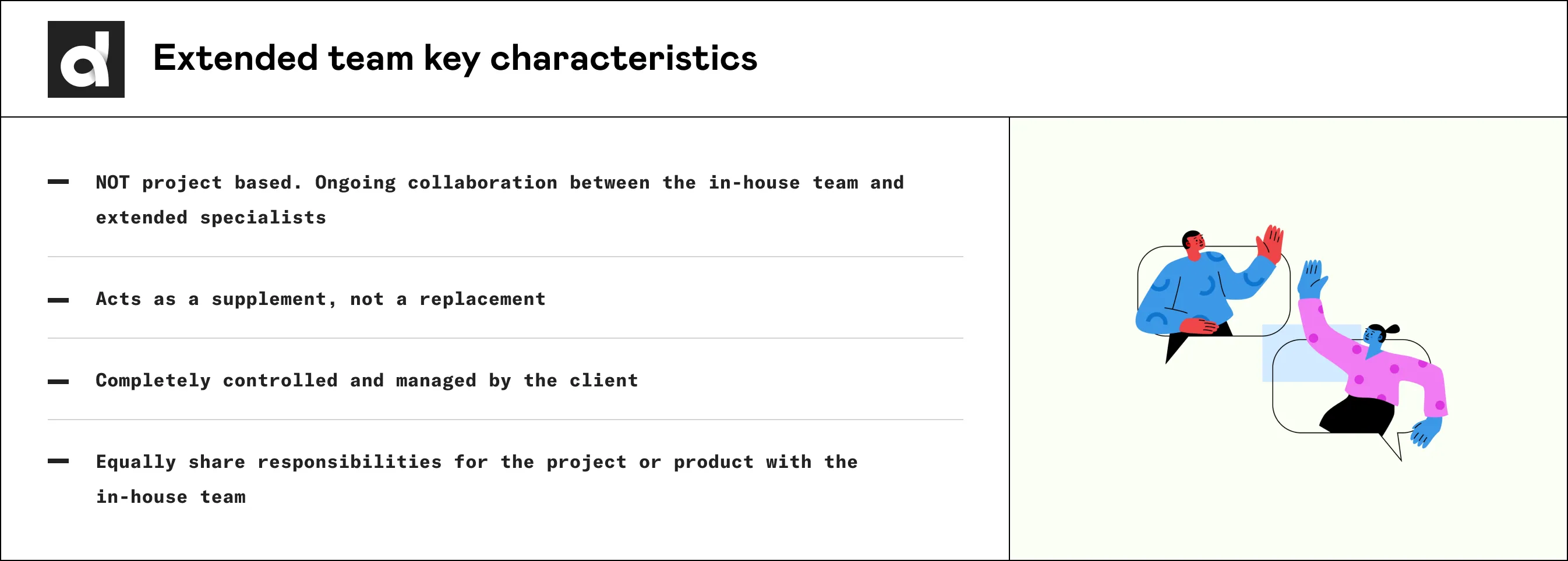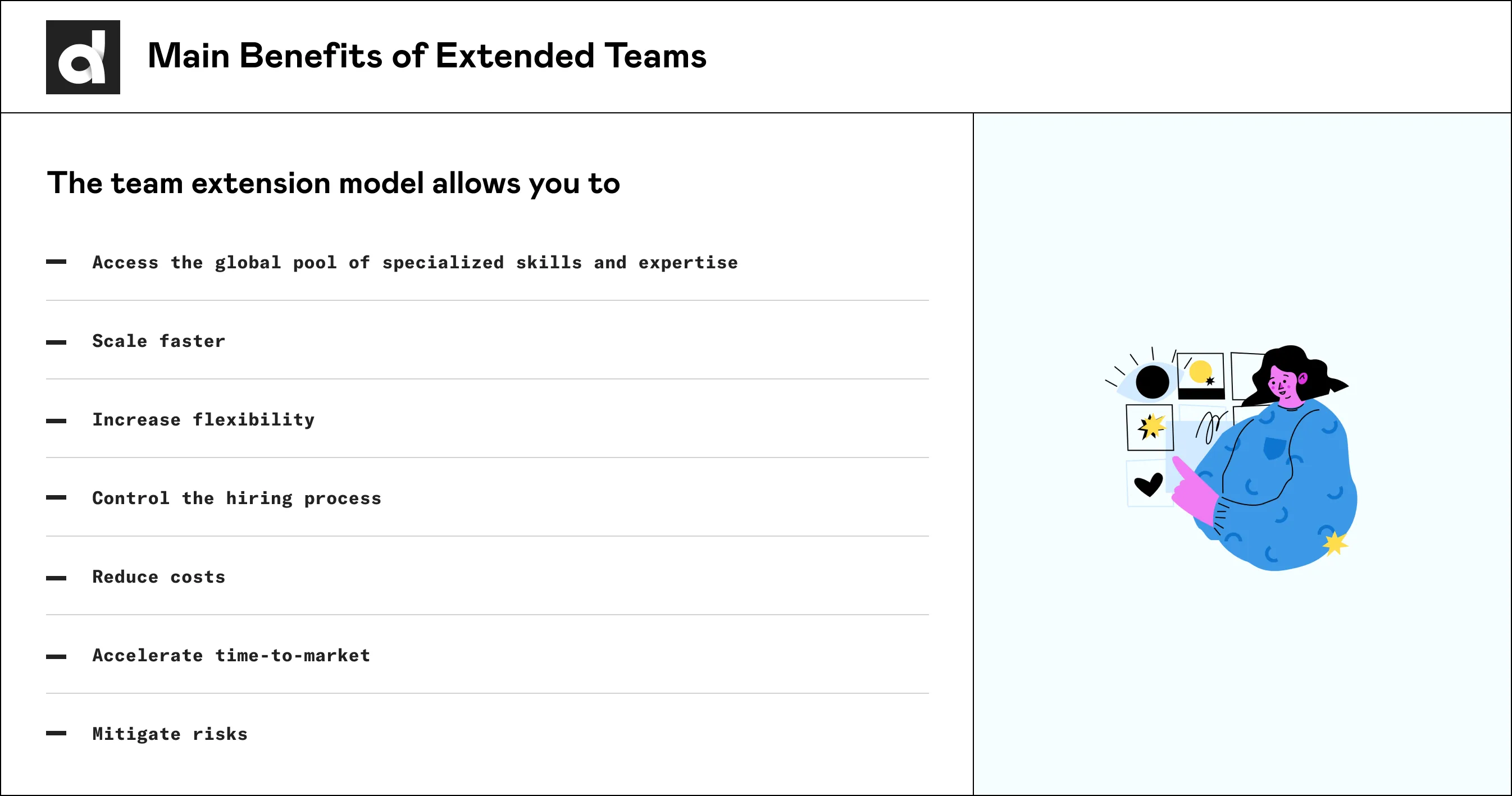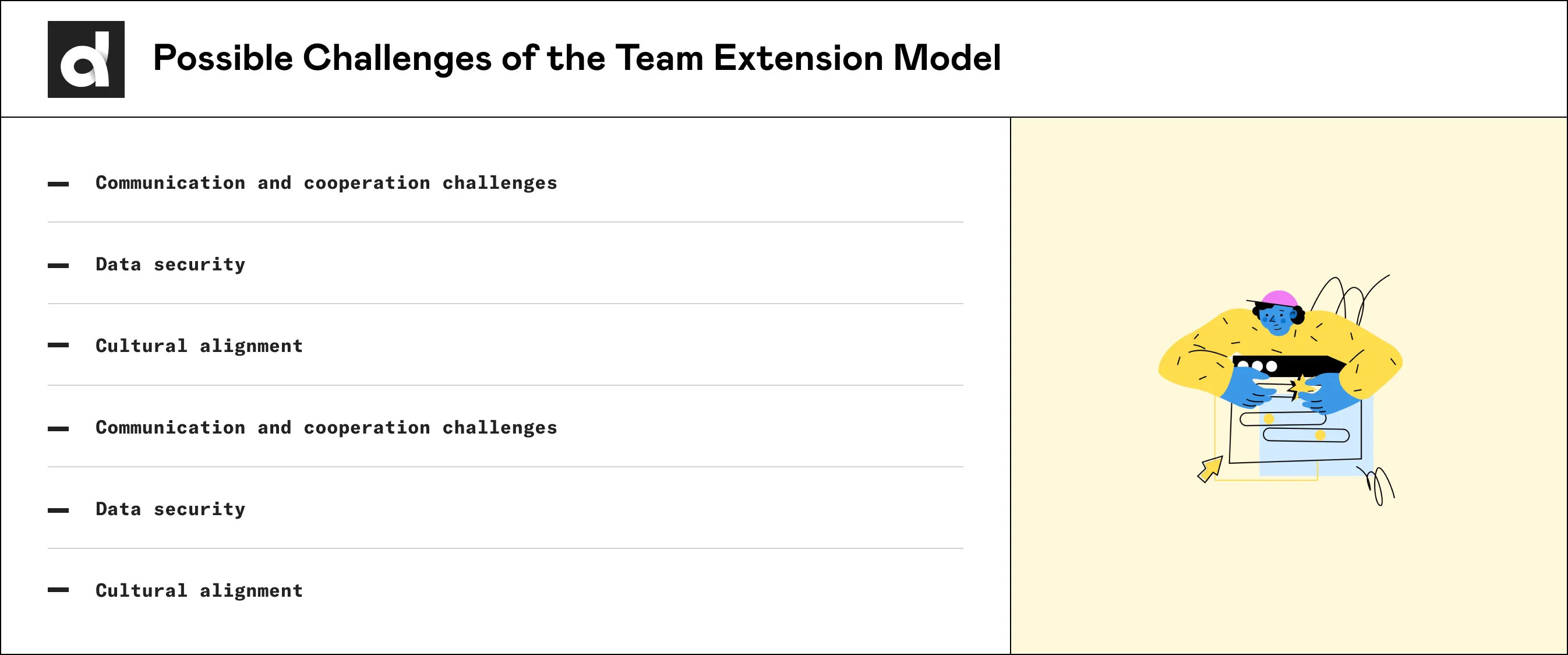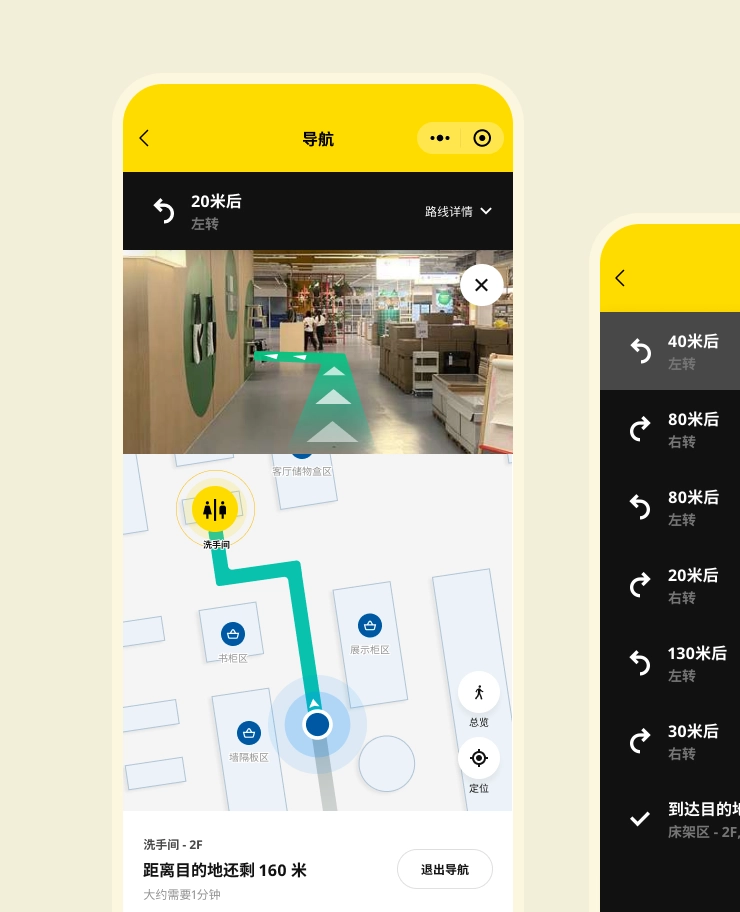Team Extension Model: How To Scale Faster And Boost Efficiency
July 6th, 2023 · Written by Zippora Lau

Contents
The team extension model has become one of the most popular alternative hiring methods for businesses worldwide. Many companies have embraced this outsourcing approach to scale their teams quickly, access specialized skills, and boost project delivery timelines.
As technology advances and competitive pressures intensify, businesses increasingly turn to staff augmentation services. According to MarketWatch, the demand for these services is set to skyrocket. Deloitte's report further reinforces this trend, projecting a global spend of a staggering 971 billion dollars on outsourcing and shared services by the end of 2023.
In this article, we will explain how the team extension model works, explore its benefits, look at the possible challenges it may bring, and how it differs from other outsourcing models like dedicated development teams. Moreover, we'll guide you through the process of finding and hiring an extended team that perfectly aligns with your business needs, propelling your success to new heights.
What Is an Extended Team?
An extended team, or team augmentation, is a business practice that involves expanding your internal team to execute a project that isn't feasible to handle with permanent staff alone. In this model, the project development remains in-house, with your existing team members retaining their responsibilities and assignments.

Depending on the arrangement, it involves hiring skilled individuals who work remotely or onsite and function as an extension of the core team. These extended team members align their efforts with the in-house team, contributing their expertise, skills, and knowledge to achieve project goals.
Extended Team Model vs. Dedicated Development Team Model
While team extension and dedicated development models are types of software development services, they are not exactly the same.
The extended team model is designed to seamlessly integrate external professionals into your existing in-house team, bringing in specific skills and expertise as required. What sets this model apart is that the extended team members adhere to the same rules, policies, and company culture as your permanent employees. They become an integral part of your organization, following your company's guidelines, adapting to its culture, and being directly managed by you.
It is not a single project-based arrangement; extended team members focus on fulfilling your business's internal needs and working towards your company's goals. By aligning with your objectives and priorities, they contribute to your long-term success and help drive your business forward.
The dedicated development team model involves outsourcing an entire team to work exclusively on a project. This team operates independently, is often led by a project manager, and is responsible for delivering the project from start to finish. This model proves highly effective when you need a self-sufficient, focused team dedicated to a specific project or product development. By leveraging the dedicated development team model, you gain access to a cohesive unit of experts solely dedicated to achieving your project goals, ensuring seamless execution and optimal results.
What Are the Main Benefits of Team Extension

Access the global pool of specialized skills and expertise.
Choosing team augmentation allows businesses effectively tap into a vast and diverse pool of talent and expertise that extends beyond the limitations of their local market. No longer confined to geographical boundaries, you can seek specialists who possess the specific skills and experience needed to drive your project forward while potentially lowering costs.
Scale faster.
With team extension, scaling your business becomes a breeze. You can quickly onboard additional team members or reduce the team size without the hassles of lengthy recruitment or termination processes. This agility allows companies to adapt to changing business requirements and allocate resources efficiently. Whether you need to ramp up or streamline operations during slower periods, team extension offers flexibility to scale your team according to your needs.
Increase flexibility.
This approach makes accommodating your extended team members in a traditional office setting unnecessary. Leveraging modern digital technologies, team members can effectively work from anywhere worldwide, ensuring efficient remote communication and collaboration.
Control the hiring process.
The team extension model simplifies finding suitable candidates and saves time and money. Instead of going through the hassle of screening numerous candidates, you'll be presented with a carefully selected pool of top-notch professionals who are ideally suited for the positions you need to fill. You can personally screen and interview these candidates, allowing you to maintain control over the hiring process. This ensures that you choose the best fit for your team and saves you the effort of sifting through countless resumes. With team extension, you can streamline your recruitment process, handpick talented individuals, and focus on the tasks at hand.
Reduce costs.
Hiring full-time employees can be a significant financial commitment for businesses. With the team extension model, organizations can temporarily engage external resources, saving on the long-term costs of hiring full-time employees.
Cost efficiency is also one of the critical advantages of team extension, particularly for businesses in more developed areas where local talent can come at a premium. Extending your in-house team with dedicated skilled specialists remotely allows you to access top-notch professionals from the global talent pool and stay within your budget.
Accelerate time-to-market.
The extended team can accelerate timelines by providing extra staffing and expertise to speed up product development. By expanding your team, you can distribute workloads, reduce bottlenecks, and increase efficiency. This dynamic collaboration lets your in-house team focus on core tasks while the extended team tackles additional responsibilities. With their support, projects gain momentum, backlogs are cleared, and tasks are completed more efficiently.
Mitigate risks.
There can be inherent risks when hiring remote developers juggling multiple projects. With a well-sourced extended team, you can alleviate concerns about instability and missed deadlines. These specialists are fully dedicated to your business goals and seamlessly integrate into your company.
Key Challenges of Team Extension to Consider

Communication and cooperation challenges.
Effective communication and coordination can be more complex in the extended team model, especially if team members are spread across different locations and time zones. To overcome these challenges, it is crucial to establish clear rules and dependencies.
By proactively addressing communication complexities and establishing a strong framework for coordination, you can effectively manage your extended team and ensure smooth sailing for everyone.
Cultural and organizational alignment.
When working with external team members, it's important to consider that they may come from different backgrounds. This can lead to variations in work culture, values, and approaches. If your in-house developers can’t effectively communicate with the extended team due to cultural differences or a language barrier, it can affect efficiency. But by embracing these differences and actively managing them, you can create an environment that promotes smooth collaboration and maximizes the team's collective strengths.
Data security.
Sharing sensitive information with external team members introduces potential data security and intellectual property risks. Ensure the necessary agreements are in place to protect confidential information and ensure compliance with legal and contractual obligations.
Team dynamics.
Building strong team dynamics and fostering cohesion can be challenging for extended teams. Core and extended team members potentially having different levels of familiarity, trust, and rapport may vary. To overcome this, promoting open communication and establishing shared goals is crucial.
Ongoing expenses.
While the team extension model is known for its cost efficiency in outsourcing developers, it's important to note that it doesn't guarantee consistently low operational costs. Having an extended team fully committed to your company and working exclusively as part of your in-house staff brings stability and mitigates risks. However, it's essential to ensure timely payment of their salaries.
Consider alternative collaboration models if you're operating on a tight budget. The fixed price model allows you to set a predetermined budget for a specific project. In contrast, the dedicated development model enables you to pay for the time spent on the project. Assess your financial situation and project requirements to choose the collaboration model that best aligns with your budget and goals.
While these possible challenges exist, they can often be mitigated with careful planning, proactive management, and communication. You should evaluate your business's specific needs and circumstances to determine if the team extension model is the right fit and take appropriate steps to address the potential challenges.
7 Key Triggers for Team Extension: How to Excel with Augmented Staffing

The extended development team hiring model can be a favorable option in various scenarios:
-
You have long-term plans to scale your product and will require ongoing support and updates. Team extension allows continuity and cohesion for seamless future expansion.
-
You are undertaking a project outside your in-house team's typical scope and/or expertise. In this case, an extended team will allow you to integrate specialists with a specific skillset without diverting focus from your core team.
-
You need to achieve a balance between quality and cost-efficiency for your project. Your local talent pool might not offer the right specialists at competitive rates.
-
You plan to expand into new markets and require local expertise. Team augmentation is the right choice for geographical expansion and new market entry. Hiring professionals with local market knowledge and language proficiency can help navigate cultural nuances, compliance requirements, and industry-specific challenges.
-
Your project experiences seasonal peaks and only requires additional resources for a limited duration. You can supplement your core team with external resources during these high-demand periods and seamlessly scale down when the workload subsides, optimizing resource allocation and cost-effectiveness.
-
You need to expedite the project delivery. Team extension can accelerate the development cycle if you need to scale fast and consider time-to-market.
-
Your project requires knowledge of specialized tools and/or technologies. Team augmentation can grant you access to specialized tools, technologies, or infrastructures that may not be readily available within your organization. External professionals may possess expertise in utilizing specific software, platforms, or equipment, enabling your project to leverage advanced resources without incurring significant investments or learning curves.
How To Find A Reliable Team Extension Partner
Investing time in thorough research and due diligence is critical when finding a reliable team extension partner. Consider these factors to help you make an informed decision:
-
Company reputation: Look for companies or agencies with a strong reputation in team extension services.To assess their reliability and expertise, check for a proven track record and industry recognition.
-
Client testimonials: Validate their capabilities by checking case studies, client references, or testimonials from previous clients. This firsthand feedback can provide insights into their performance and client satisfaction.
-
Cultural fit and communication: Ensure the partner is a good cultural fit for your organization. Effective communication is crucial, so check if they can communicate clearly in your language. Responsive communication channels are essential for seamless collaboration.
-
Your requirements: Clearly outline the specific skills, expertise, and experience you need from the extended team. Consider factors like project scope, technology stack, and project timeline. This clarity will help you find a partner that aligns with your needs.
-
Security and confidentiality: Discuss their approach to data security, intellectual property protection, and confidentiality agreements. It's crucial to ensure your sensitive information will be handled securely.
-
Pricing: Compare pricing models and ensure they offer transparent pricing structures that fit your budget. While cost is important, focus on the value and expertise they bring to your project rather than solely opting for the lowest price.
Digital Creative Can Help You Find The Right Team Augmentation Solution
Finding a reliable team extension partner is crucial for your business's success, and that's where Digital Creative can help. We have a proven track record of building efficient and scalable extended team solutions for leading companies in China and worldwide.
Being located in China gives us a unique advantage - access to a highly skilled and cost-efficient talent pool. We know exactly how to find the perfect extended team solution that matches your requirements and ensures a smooth journey from our first conversation to successful project completion.
At Digital Creative, we understand the importance of effective communication and collaboration. Our team is well-versed in remote work methodologies and uses cutting-edge collaboration tools to ensure seamless interactions and keep track of project progress. Our multilingual team of professionals will make sure there are no language or cultural barriers between us.
When you choose Digital Creative as your team extension partner, you're not just getting technical expertise. You're gaining a collaborative ally with a creative mindset, technical brilliance, and a knack for innovative problem-solving.
Let's schedule a call today, and together we'll find the best augmented staffing solution for your unique needs.
FAQ
-
What is staff augmentation?
Staff augmentation is a flexible hiring model where organizations supplement their internal teams with external professionals to meet specific project requirements. These professionals work as an extension of the in-house team and provide specialized skills, expertise, and resources. -
What is team extension?
Team extension is a form of staff augmentation where organizations augment their internal teams by hiring external professionals to work collaboratively on a project. It involves extending the team's capabilities by integrating external resources into the workflow. -
What are the benefits of staff augmentation and team extension?
The benefits include access to specialized skills, scalability, cost-effectiveness, flexibility, reduced recruitment time, knowledge transfer, and increased productivity through shared workloads. -
How does team extension differ from traditional hiring?
Traditional hiring involves recruiting full-time employees for permanent positions within the organization, whereas the extended team model focuses on hiring external professionals on a project-specific or temporary basis. -
What is the typical duration of team extension engagements?
The duration can vary depending on the project requirements. Engagements can range from a few weeks to several months or even longer term based on the project scope, complexity, and timeline.
Have a project in mind?
Join our newsletter!
Get valuable insights on the latest digital trends, strategies, and developments in China and globally delivered straight to your inbox.

